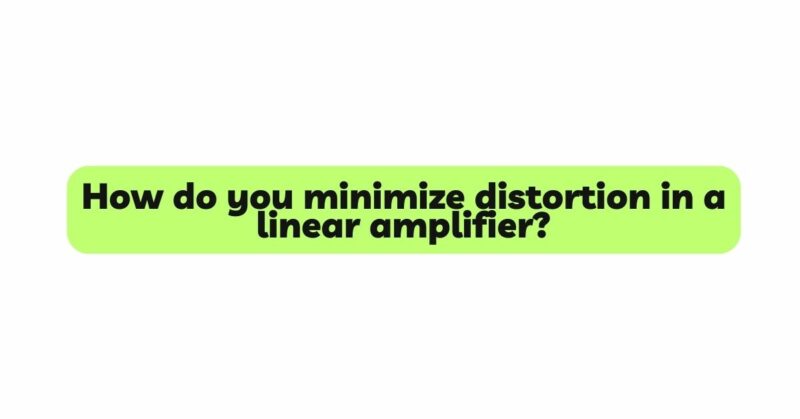The pursuit of sonic clarity and fidelity is a fundamental goal for audio enthusiasts, engineers, and musicians alike. Linear amplifiers, designed to faithfully reproduce an input signal without altering its shape or characteristics, play a crucial role in this quest. However, even the best linear amplifiers can introduce a certain level of distortion. In this comprehensive guide, we will delve into the intricacies of minimizing distortion in linear amplifiers, exploring the technical factors, best practices, and advanced techniques that contribute to achieving a pristine and unadulterated audio output.
Understanding Linear Amplifiers
A linear amplifier is designed to produce an output signal that is a faithful replica of the input signal, scaled up by a constant factor (the gain). However, real-world limitations and the complexities of components introduce distortions that may compromise this ideal.
Types of Distortion in Linear Amplifiers:
- Harmonic Distortion: Introduces harmonics that are integer multiples of the input frequency.
- Intermodulation Distortion: Occurs when two or more frequencies interact, generating sum and difference frequencies that were not present in the original signal.
- Phase Distortion: Results in a shift in phase relationships between different frequencies in the signal.
Strategies for Minimizing Distortion in Linear Amplifiers
Achieving minimal distortion in a linear amplifier requires a combination of design considerations, component choices, and meticulous attention to signal processing.
1. Quality Component Selection: The choice of components—such as transistors, resistors, capacitors, and op-amps—directly influences the amplifier’s performance. Opt for high-quality, low-distortion components from reputable manufacturers.
2. Linear Frequency Response: Ensure that the amplifier’s frequency response is as linear as possible across the entire audible spectrum. This reduces the likelihood of introducing frequency-dependent distortions.
3. Negative Feedback: Incorporating negative feedback in the amplifier’s design helps reduce distortion by comparing the output to the input signal and correcting discrepancies.
4. Minimizing Nonlinearities: Design the amplifier’s stages to operate within their linear regions as much as possible. Nonlinearities that occur near the boundaries of operation can lead to distortion.
5. Low Noise Floor: A low noise floor allows the amplifier to accurately reproduce low-level signals without amplifying noise. Minimizing noise ensures that the true dynamics of the signal are preserved.
Advanced Techniques for Distortion Minimization
Taking distortion reduction to the next level involves advanced techniques that require precision, expertise, and meticulous implementation.
1. High-Fidelity Components: Utilize components designed specifically for high-fidelity audio applications. This includes audiophile-grade capacitors, resistors with low temperature coefficients, and precision op-amps.
2. Class A Amplification: Class A amplifiers are biased to operate in their most linear region, minimizing distortion at the expense of higher power consumption and heat generation.
3. Balanced Signal Paths: Implementing balanced signal paths and differential amplification helps reject common-mode noise and interference, resulting in cleaner and less distorted output.
4. Distortion-Canceling Circuits: Advanced distortion-canceling circuits can be incorporated to actively counteract and nullify specific types of distortion introduced by individual components.
5. Feedback Network Optimization: Carefully tuning the negative feedback network allows for precise control over distortion reduction. This involves adjusting gain stages and feedback loop parameters.
Implementing Best Practices
To minimize distortion in a linear amplifier effectively, certain best practices should be observed consistently.
1. Grounding and Shielding: Proper grounding and shielding techniques prevent interference and noise that can contribute to distortion. Maintain a clean and well-organized circuit layout.
2. Heat Management: Excessive heat can impact the performance of components and introduce distortion. Adequate ventilation and heat sinks are essential to maintain optimal operation.
3. Component Matching: Matching components that work in pairs or sets—such as transistors—ensures balanced performance and reduces distortion due to mismatches.
4. Careful Wiring: Neat and precise wiring minimizes the risk of crosstalk, interference, and unintended coupling that can lead to distortion.
5. Regular Maintenance: Regularly inspect and maintain the amplifier’s components and circuitry to prevent issues that may lead to distortion over time.
Conclusion
Minimizing distortion in a linear amplifier is a multifaceted endeavor that combines technical knowledge, precision engineering, and meticulous attention to detail. By understanding the types of distortion, implementing strategies for distortion reduction, exploring advanced techniques, and adhering to best practices, you can achieve an audio output that approaches the realm of sonic perfection. While absolute distortion elimination may be an elusive goal, the pursuit of minimal distortion brings you closer to the true essence of your audio source, allowing you to appreciate its nuances, dynamics, and textures with unparalleled clarity and fidelity.


